Kaylee has claimed a new spot.

Kaylee has claimed a new spot.

No trip to Puerto Rico is complete without going deep underground to explore Camuy Caverns, officially known as Rio Camuy Cave Park. It’s located in the karst mountains of northwestern Puerto Rico, where the towns of Camuy, Hatillo, and Lares come together. It was fascinating to see what nature wrought over millions of years, as well as the huge impact of Hurricane Maria.
Make sure you stay till the end: There is surprise bonus material you won’t want to miss!
We travel with a very sweet cat, Kaylee. She’s a petite Maine Coon, very affectionate but also very nervous.
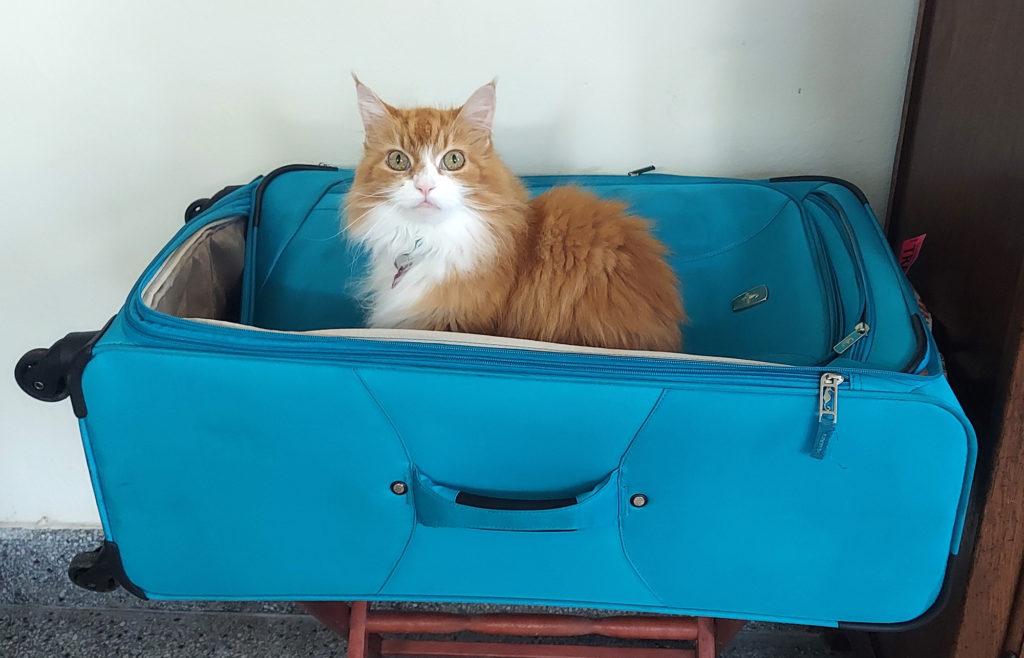
She technically belongs to our oldest child, Aryk, but as Aryk is still finishing grad school in England, Kaylee travels with us.
And she doesn’t like it.
It’s not easy for us, either. But we wouldn’t have it any other way.
Flying with a cat companion is a logistical challenge. Here are the many steps:
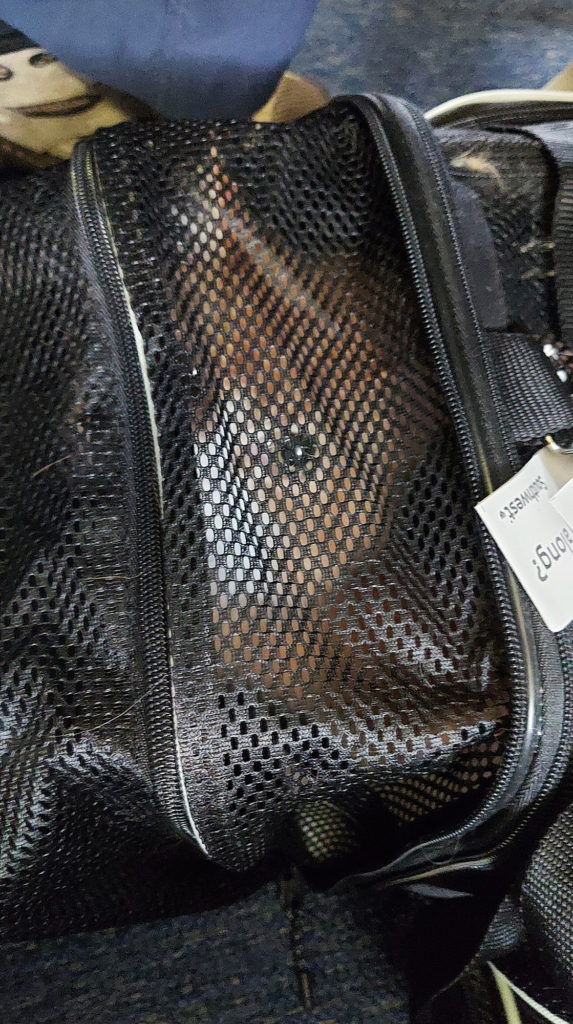
In addition, to bring Kaylee to Puerto Rico, we had to get an international health certificate, which entailed finding a specific kind of vet and paying $240 for the paperwork, an extra exam, and extra shots. And then the authorities in PR didn’t even ask to see any of it! We have done this twice. I spoke to a dog owner here who did it for three dogs, at much greater expense because of their large size, and no one asked to see their paperwork, either. I know if we skip this step, though, the authorities will ask for it and send her back to the States.
Kaylee can always tell when we are about to move. When our suitcases come out, she starts looking for hiding places — and we start looking for ways to keep her out of those hiding places. We once had to practically disassemble a bed in a motel when she climbed up inside the box frame.
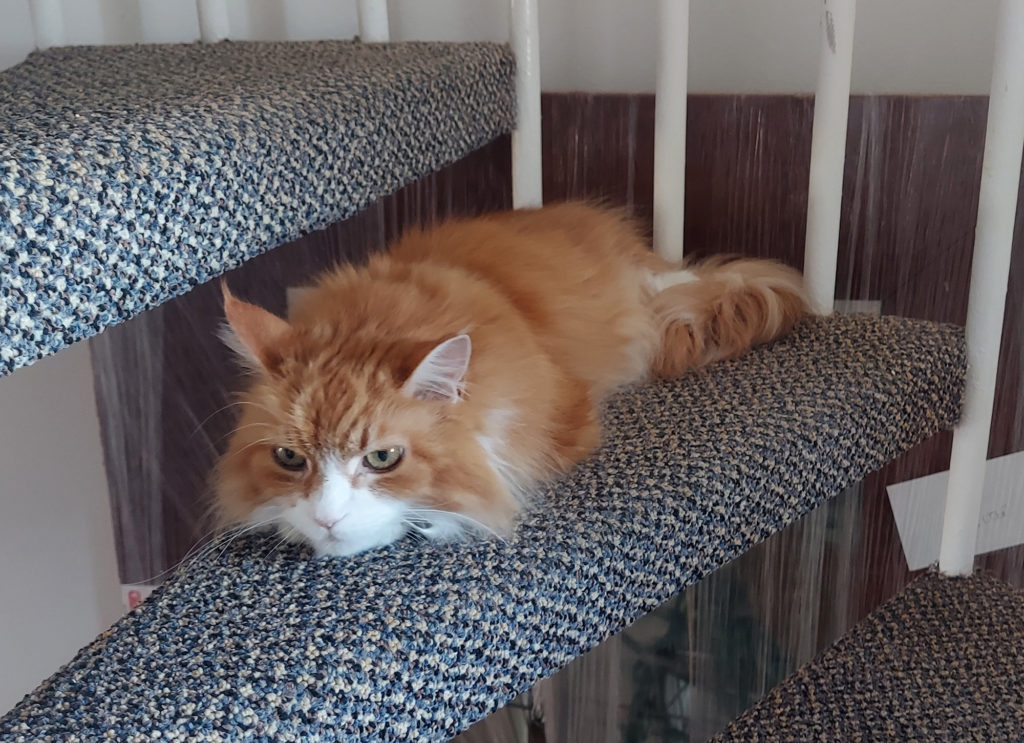
Alleviating Kaylee’s anxiety about flying is crucial, so we got gabapentin, an anti-anxiety medicine, from the vet, which has helped Kaylee endure the terrifying airport screenings and long periods stuck in the carrier. Usually. It does wear out, though. You can tell because she starts thrashing and meowing. A friend who operates a doggie daycare suggested I play a calming playlist from Amazon music. This works miracles! I just place the phone on her carrier to act as her private concert hall, and she is calmed instantly. Thank you, Cesca Ferrante Segalas!
Cats like routine, and life is always changing when you travel. We manage Kaylee’s stress as best we can, but there’s a limit to what we can do. Sometimes local cats meow outside the windows at night, or come up to the door during the day. Humans shove her into carriers with no warning, and sometimes leave her there for hours while we travel in cars or planes. Food on the road is inconsistent, depending on what’s available where we are loving at the time. The environment changes monthly, when we move to a new condo. (This is part of the reason we bought the house in Cabo Rojo.)
Kaylee’s buddy Ellie, our Russian Blue who lives at college with Gavin, may be in the house for months (over summer break), and then, just when they have finally adjusted to each other (again), will abruptly disappear with no explanation.
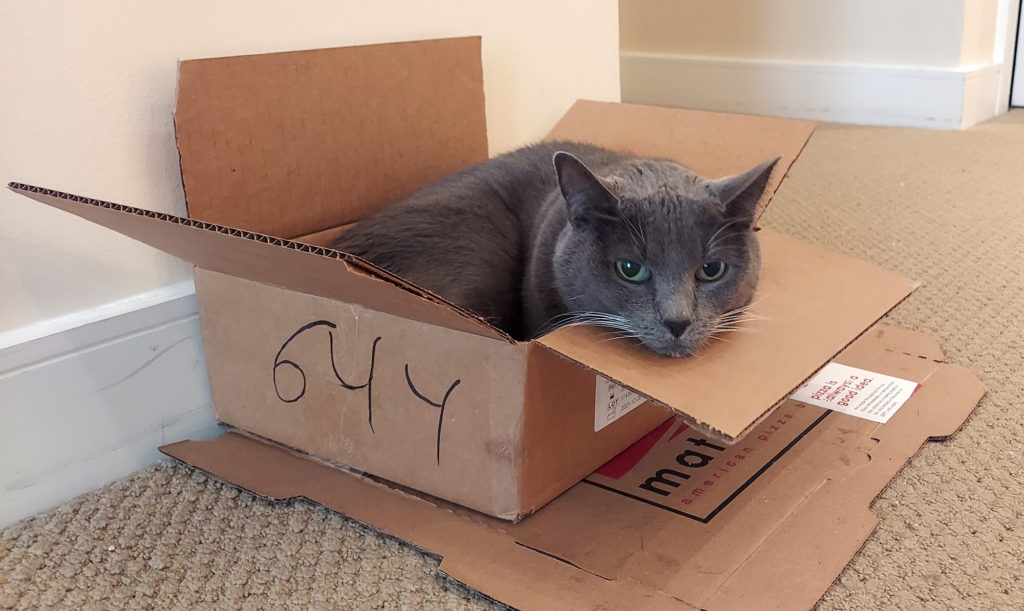
Once, while living in Mexico City, we put Kaylee in boarding while we took a short jaunt to Acapulco. We had to return early due to COVID, but the vet was calling anyway, saying our kitty was freaked out by another cat who wouldn’t stop yowling. We arrived to find her hiding in the kitty playroom, her body tucked deeply into the bottom tire in a stack.
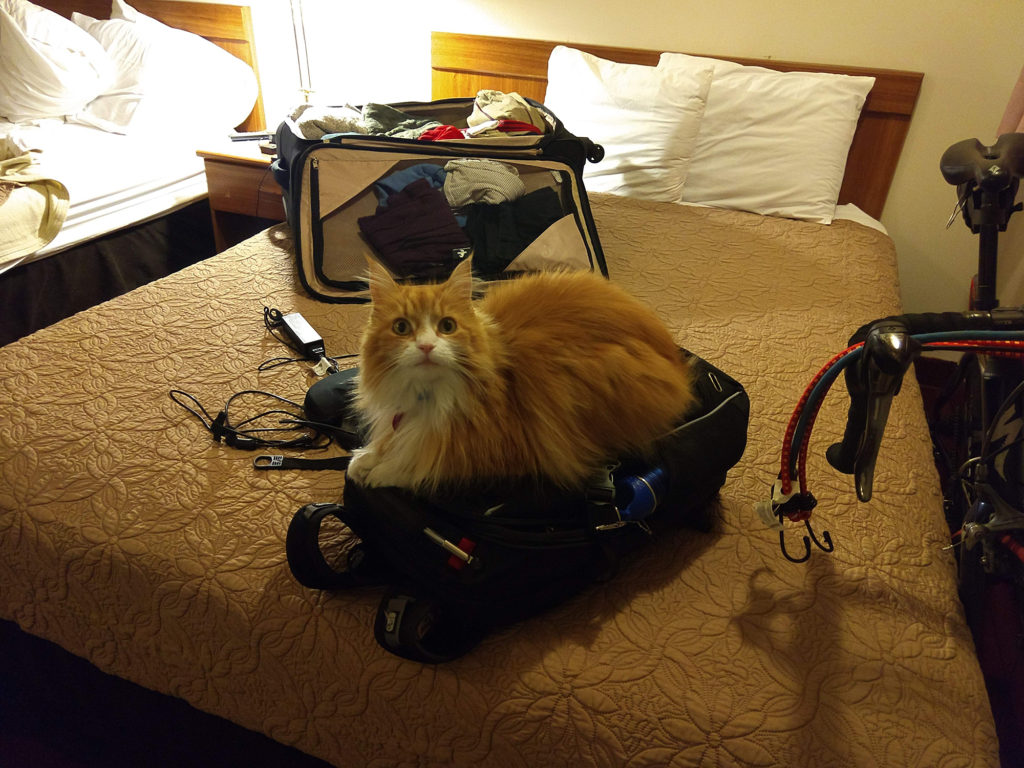
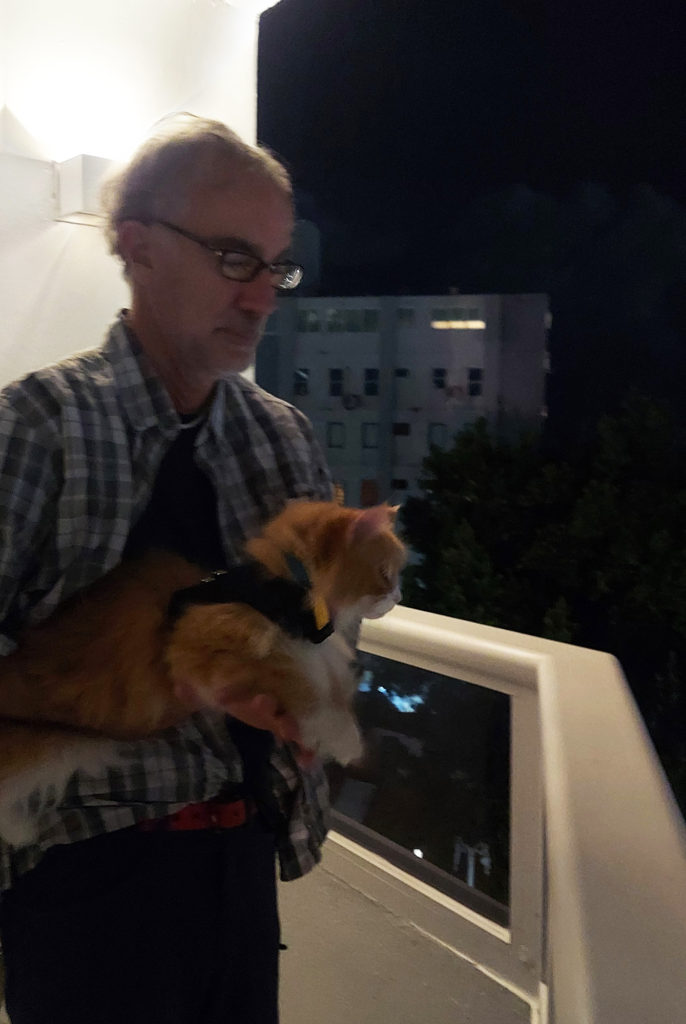
Kaylee was recently diagnosed with alopecia, after she licked all the hair off one of her furry legs. The vet said this could be caused by fleas – and told us all cats in PR should be regularly treated for fleas and heartworm – by food allergies, or by stress. We are treating her for fleas, and we’ll test for food allergies this summer if her symptoms persist. But in all likelihood, it’s anxiety. So, we make her life as easy as possible, give her tons of attention, staying home some days just to provide a lap for her to nap in, and keeping up her routines as much as we can (within limits).

Finding vets to care for cats in a place where you don’t speak the language well is a constant challenge. Their front claws must be trimmed regularly, they must be treated to prevent fleas and heartworm, and sometimes they get sick. The upside is that it’s usually less expensive anywhere else than in the States.
Our cat Equinox took ill a week into our Mexico City stay in early 2020. We found a vet within walking distance whose convenient office we had noted while exploring the city, and rushed him there. Fortunately, one vet spoke English, and he got the city’s best kitty cardiologist involved when it turned out our cat had hypertrophic cardiomyopathy. In humans, this condition is called “the widow maker” because often it’s often undetected until the patient, usually a man, has a sudden fatal heart attack. Alas, the same was true for our dear Noxy. He was hospitalized but only lived through a weekend, and had to be put to sleep in the middle of the night when he became agitated and had trouble breathing.
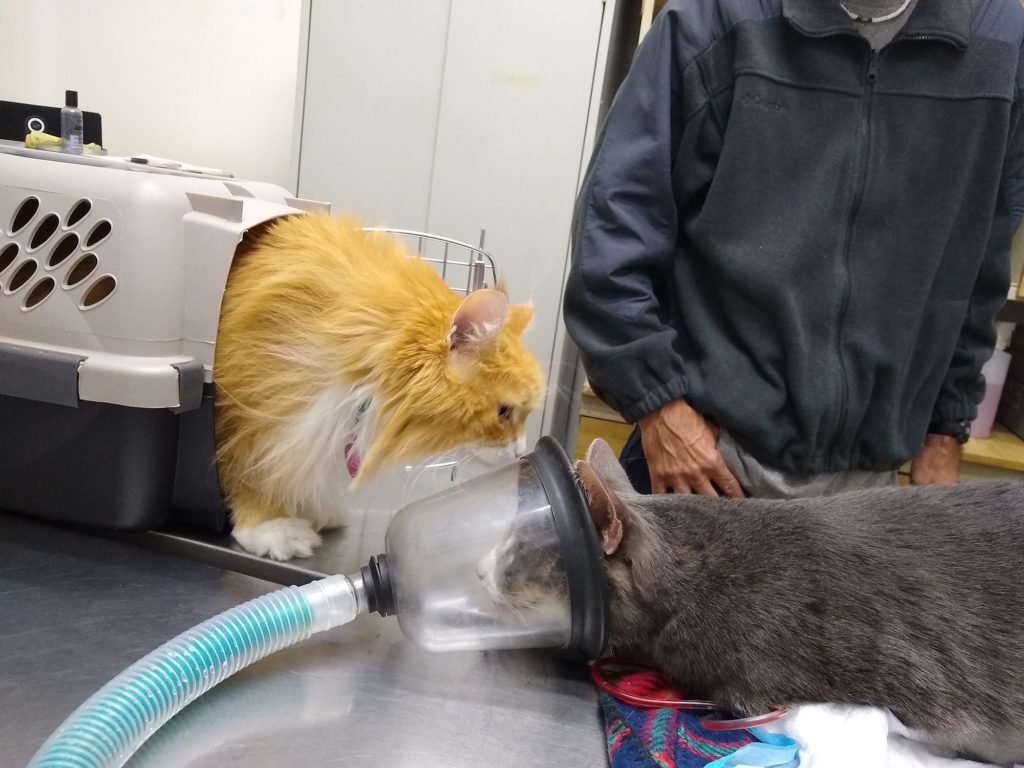
But he got excellent care. We were called in, we brought Kaylee to say goodbye to her friend, the children were called, and it was as good a pt death experience as is possible, And the cost for that care and his subsequent cremation was a fraction of the cost for the same in the States.
However, the stress of traveling and then moving to a mile-high city probably contributed to his demise, and this is why I am vigilant about managing Kaylee’s stress. The vet gave us this resource for helping keep kitty stress down: https://indoorpet.osu.edu/cats/feline-life-stressors
I hope the move to Cabo Rojo in winters will give her a more settled life. Alternating between two households should be much easier than adjusting to a new home every month! And when she finally moves in with her owner, our oldest child Aryk, we will probably stick to healing aid organizations care for all the stray cats in Puerto Rico.
Meanwhile, whenever I sit down to use the computer, read a book, or watch TV, I lay Kaylee’s favorite towel across my lap and call her name. She is here in an instant, ready to cuddle while I work. In fact, she is in my lap right now!
Because despite all the stress, the most important thing I can do for my traveling cat is to give her love.
We drove west from Isabela to explore the Cara del Indio (Face of the Indian), Cueva del Indio (Cave of the Indian), and anything else we stumbled upon, including Taino and Spanish ruins, ocean arches, and one disgraced explorer.
The Cara del Indo, a giant face carved into a hillside rock at the entrance to the coastal town of Isabela, represents Cacique (chief) Mabodamaca, a Taino leader who tried to protect his people from the Spanish trying to take the land. The chief’s giant visage welcomes visitors to Porta del Sol (Gateway of the Sun), the west coast region of Puerto Rico.
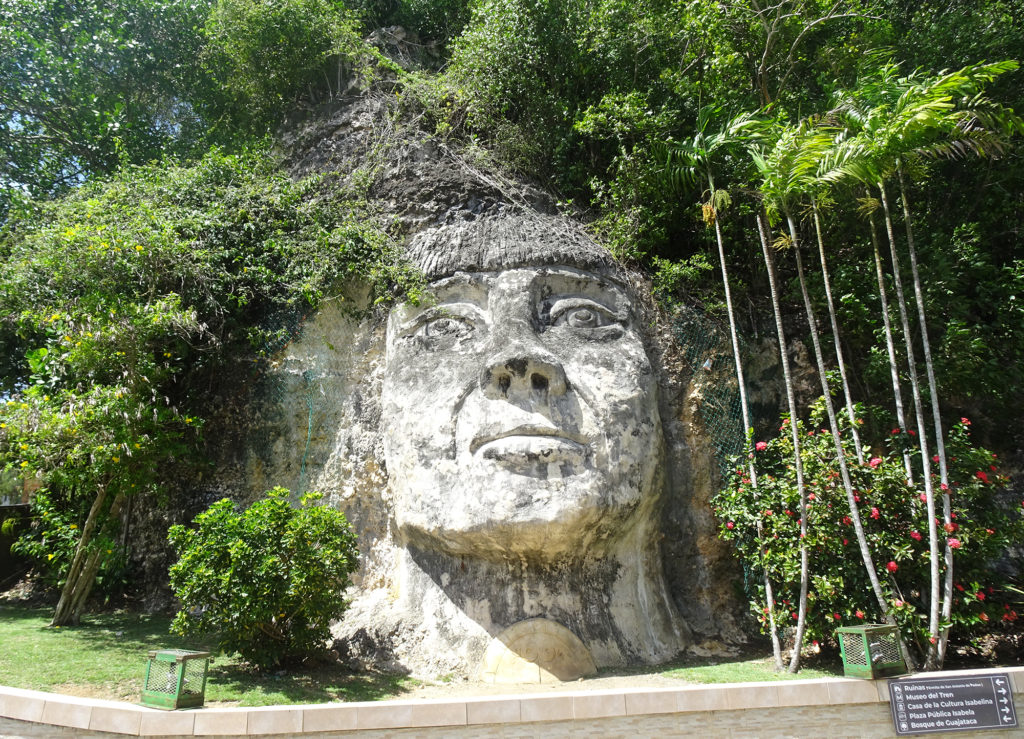
Located farther east in the northcoast town of Arecibo, the Cueva del Indio is an impressive cave surrounded by dramatic cliffs that face the Atlantic Ocean. The cave gets its name from the pre-Columbian indigenous petroglyphs that are found in the walls of the cave.
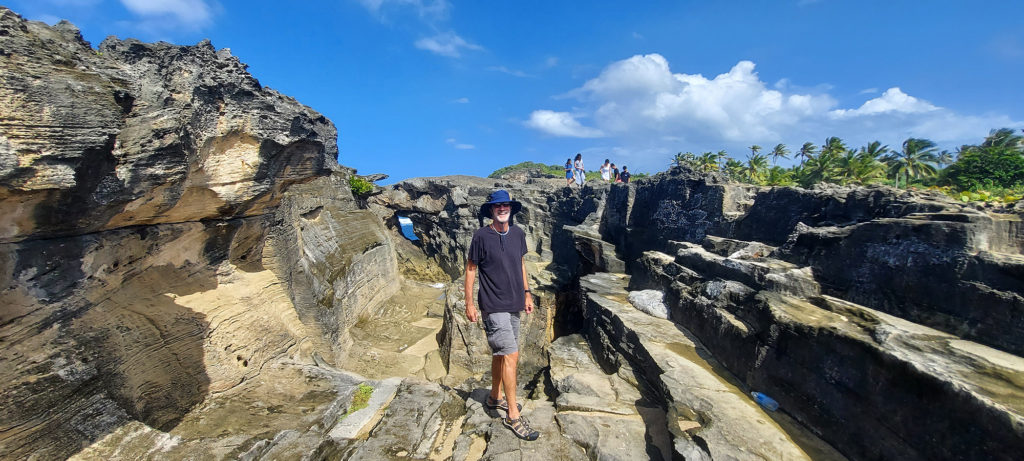
However, the climb into the cave is a young person’s activity; we peered down into the yawning chasm, and saw a couple of petroglyphs carved outside.
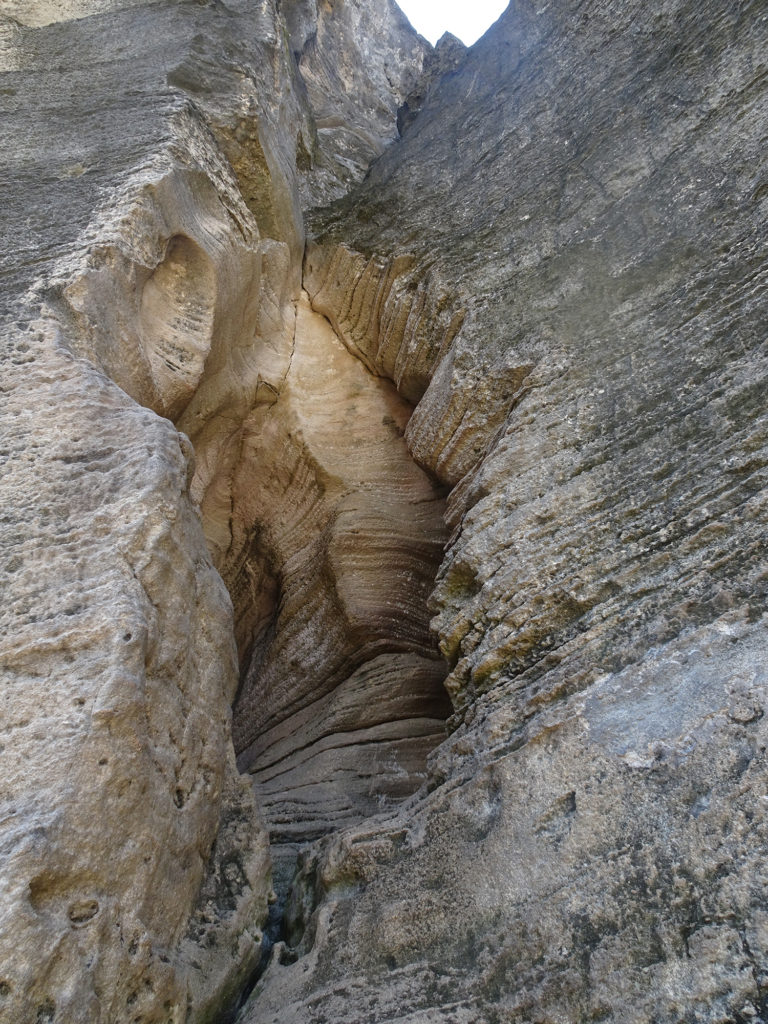
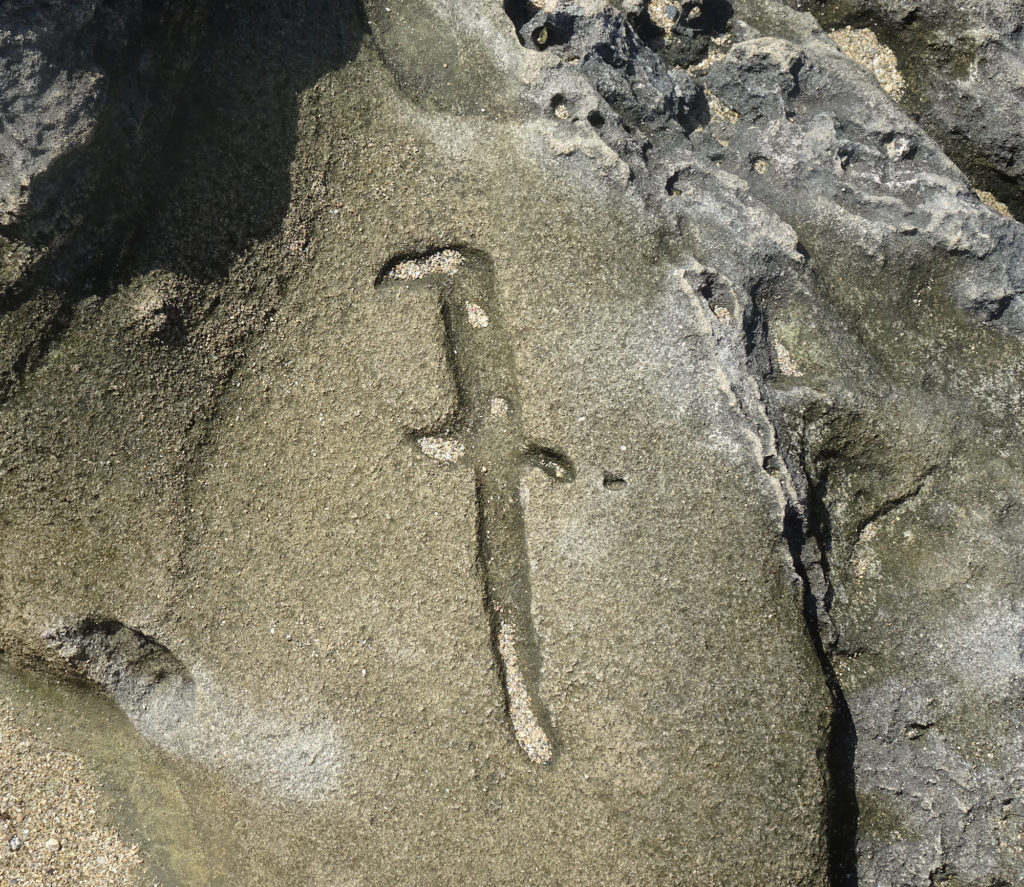
Perhaps we’ll return with better climbing shoes (since we can’t bring younger bodies) and try to get in another time.
There are also seven dramatic arches you can hike to. The hike is short but difficult, on jagged rocks under hot sun with no shade. Wear good shoes and carry water.
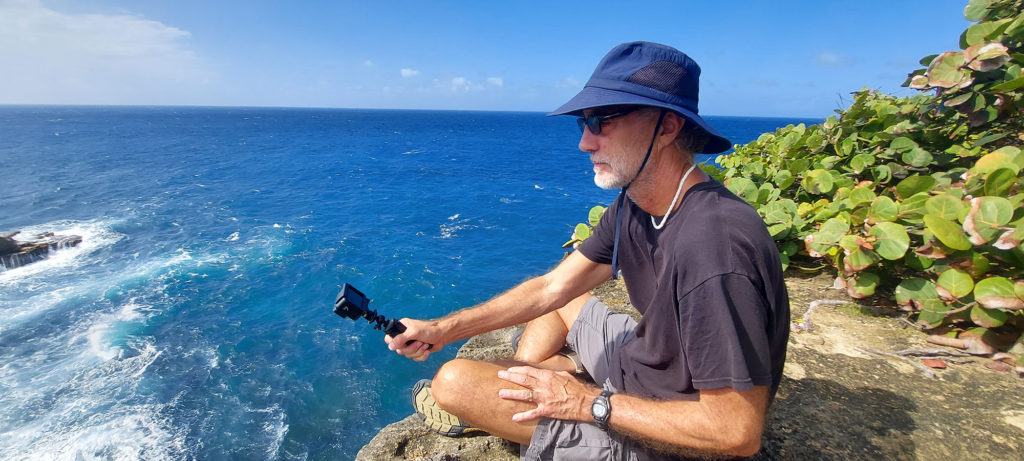
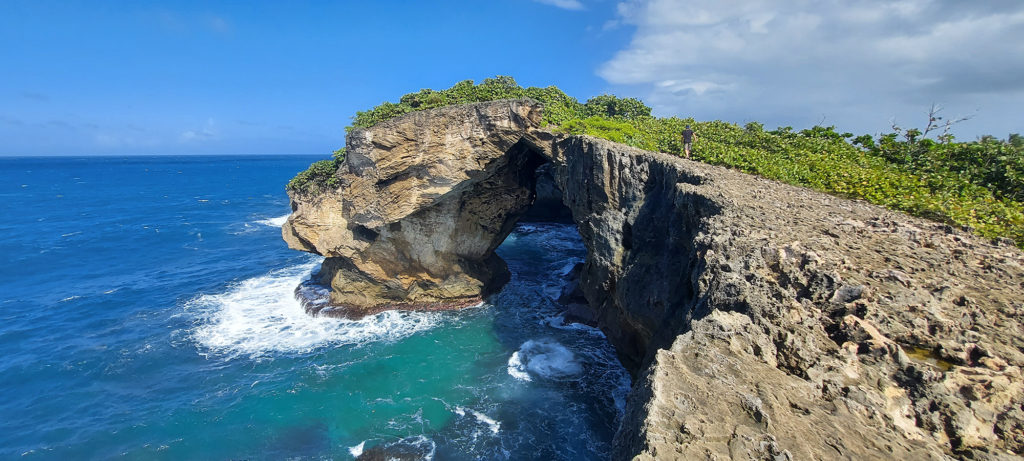
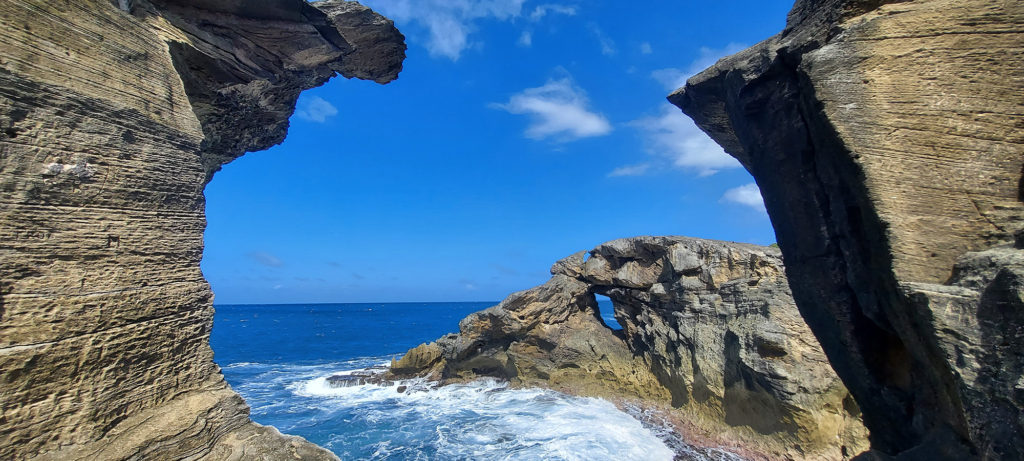
We paid $5 each at the entrance, got a short talk with photos from the park staff person, and then we were on our own.
We spotted a road sign and turned out of curiosity toward Ermita San Antonio de Padua de la Tuna, the remains of the first Spanish settlement in the northwest region of Puerto Rico. The Spanish lved here until they decided to move their community to Isabela, on the coast, but the original church remains here. Alas, the visitors center is only open on weekends, and the remains were locked up. (Ermita means Hermitage)
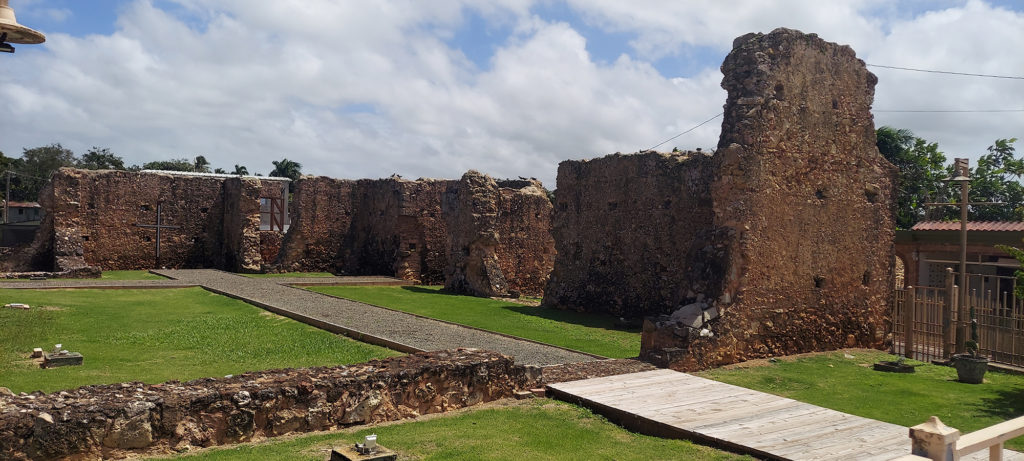
I did learn that the ruins of the original church have been preserved with help from the Mabodamaca Corporation, named was in honor of great Taino chieftain, and it is listed on the US National Register of Historic Places.
The less said about this lighthouse, the better. It’s a lovely building, but we didn’t get close. The cost was $12 apiece to get in, and the area around the lighthouse has been turned into a kids’ amusement park – even the lighthouse sign has a pirate in it.
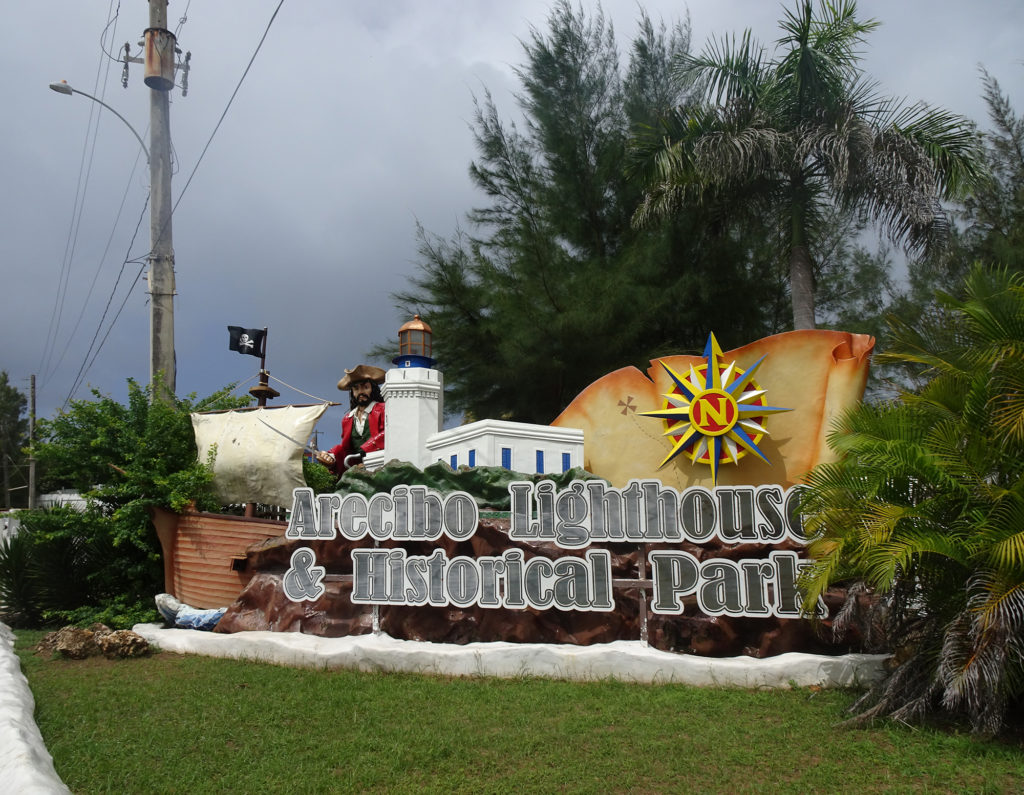
If I had brought my great-niece Audrey, I would have happily paid for half a day’s family amusement. But for a geezer and her young husband just wanting to see a lighthouse? Not worth $24.
Here’s the view from the back, from the parking lot of the next beach over. Stilll not worth $24.

Why is there a statue of Cristóbal Colón (Christopher Columbus) plunked down on a hill near the ocean in Arecibo? Inquiring minds wanted to know after we saw it looming from the Lighthouse.
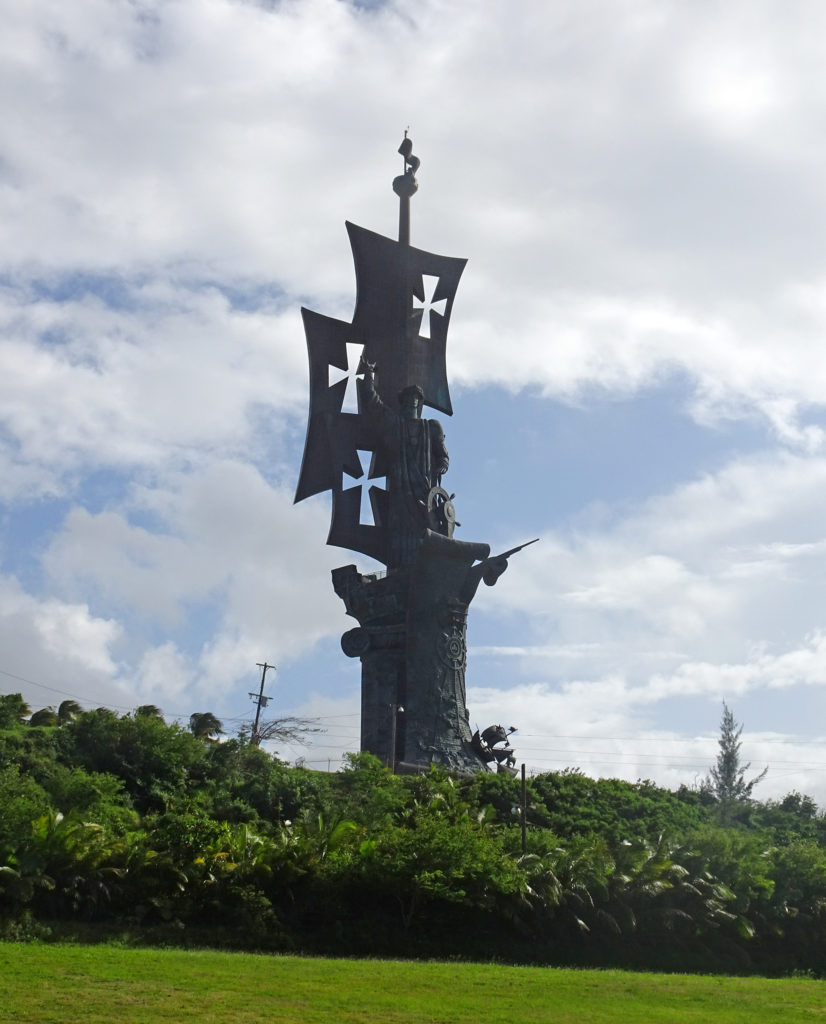
It’s a circuitous story involving a Georgian sculptor who created a gigantic statue in 1991 and then spent decades trying to find a community in the Americas to host it. During that time, Columbus’s stock plummeted as the world transitioned from calling him a conquering hero to a genocidal murderer. The artist’s options dwindled, the statue deteriorated, and he finally settled on Arecibo, given that all the other candidates had dropped out of the running. Sort of like Beijing hosting the Winter Olympics.
The name of the statue is Birth of the New World. Here is its history, according to Wikipedia:
Originally designed by Georgian sculptor Zurab Tsereteli as a monument to commemorate the 500th anniversary of Christopher Columbus‘ first voyage Birth of the New World was constructed in 1991. The statue prominently depicts Columbus controlling an anachronistic depiction of a steering wheel, with a backdrop featuring the Niña, Pinta and Santa María traversing the Atlantic Ocean.[2] Made of 2,750 bronze and steel pieces and weighting more than 1,300,000 pounds (590 tons), the monument’s 360 ft (110 m) height made it the tallest in the Western Hemisphere during the last decade of the 20th century, dwarfing the Statue of Liberty[3] and the Monumento a la Virgen de la Paz.
New York, Miami, Fort Lauderdale, Columbus, OH, Baltimore, and other cities rejected Tsereteli’s offer of the statue. In the end, a consulting firm estimated that the statue would attract at least 300,000 tourists per year. Given that we couldn’t even find parking or an entrance, and had to take shots through a fence by a narrow beach road, I would say that estimate might have been on the high side.
Read the whole sorry tale.
Cara del Indio
Cueva del Indio
Ermita San Antonio de Padua de la Tuna
Christopher Columbus History
Finding good pizza is a top priority no matter where we stay. We lived for almost two decades in and around New York City, and consequently are VERY picky about our pie.
Fortunately, we have found that the New York-Puerto Rican connection means that the island has more than its share of excellent pizza.

Here are our favorites:
Luquillo: Revolution Pizza
Revolution Pizza, at the kioskos in Luquillo, serves up excellent, genuine NY pizza. Ask for a table in the back with a view of the ocean. Come hungry, you’ll leave happy.
Info: facebook.com/RevolutionPizzaShop
Map: Kiosko #34 Km35 00773 Luquillo, Puerto Rico

San Juan: Pizzaiolo Pizza in Isla Verde
You can choose from Brazilian or NY Style pizza. This was our favorite when we lived in Ocean Park in the 1990s, and we were thrilled to discover when we returned in 2021 that is still here and still excellent.
Info: No website
Map: 3038 Av. Isla Verde, Carolina, 00979
UPDATE: This pizza shop closed on early 2022, sadly.
Isabela: Junior’s Pizza at Jobos Beach
Outdoor dining. Good cocktails. A great variety of ingredients and personal pizzas are available, so you don’t have to agree on toppings or sauces. It’s not on the beach, but a block up, with its own parking lot, which is convenient. they even made us a pizza once when they were officially closed, but the pizza guy was still hanging out after a private event. That is customer service!
Info: No website.
Map: goo.gl/maps/wSZMjRhDZJYxxPKZ8
Cabo Rojo: Papa’s Pizza
Because of COVID, we only ever had carry-out, but it was only three blocks from our apartment. It was consistently excellent.
Info: facebook.com/papaspizzacaborojo
Map: #49 Calle Rios Rivera, Cabo Rojo, 00623
Marco’s Pizza is good. Williams Pizza sucks. You can find the US chains like Papa John’s if that’s your thing.
I hope you enjoyed our guide to Puerto Rican food! Please add your recommendations and thoughts in the comments!
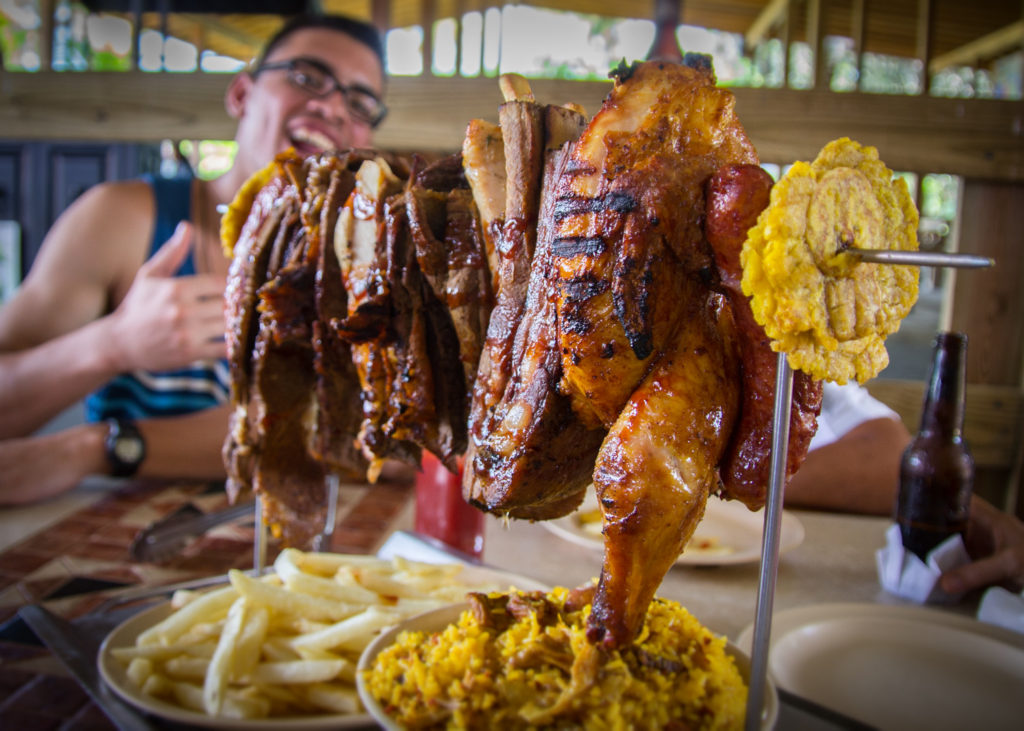
“Where are the best places to eat in Puerto Rico?”
Many prospective travelers to this wonderful island seek gustatory advice in advance, as part of their trip planning. And this is understandable! So Messy Suitcase is here to help you eat authentically and well, in a new series, The Messy Suitcase Guide to Eating in Puerto Rico.
We are of several minds about PR meal planning. First of all, most Puerto Ricans would probably say the best place to eat is in Abuela’s (Grandma’s) kitchen.
Secondly, while you’re searching for that recommended restaurant, you may be passing ten others that are just as good or better.
Everybody’s taste is different, be it flavor, style, formality, familiarity, level of spice, authenticity, or whatever makes your tongue sing. So one person’s Michelin 5-Star restaurant may be another person’s disappointment.
Half the fun of Puerto Rican food–or really, any country’s food–is making discoveries. You’re sunning on Playa Combate, the day is ending, you see lights of a restaurant twinkling at the north end of the beach. You wander over and stumble upon a restaurant overlooking the ocean at sunset, with excellent cocktails and unparalleled views. No recommendation necessary! Just explore.
Trying something new doesn’t necessarily mean you’ll like it, but it’s still important to be adventurous.
We have visited the Piñones food stands area just east of San Juan, driving along the ocean and picking out unassuming food stands from which to order traditional Puerto Rican food, prepared the way Abuela makes it.
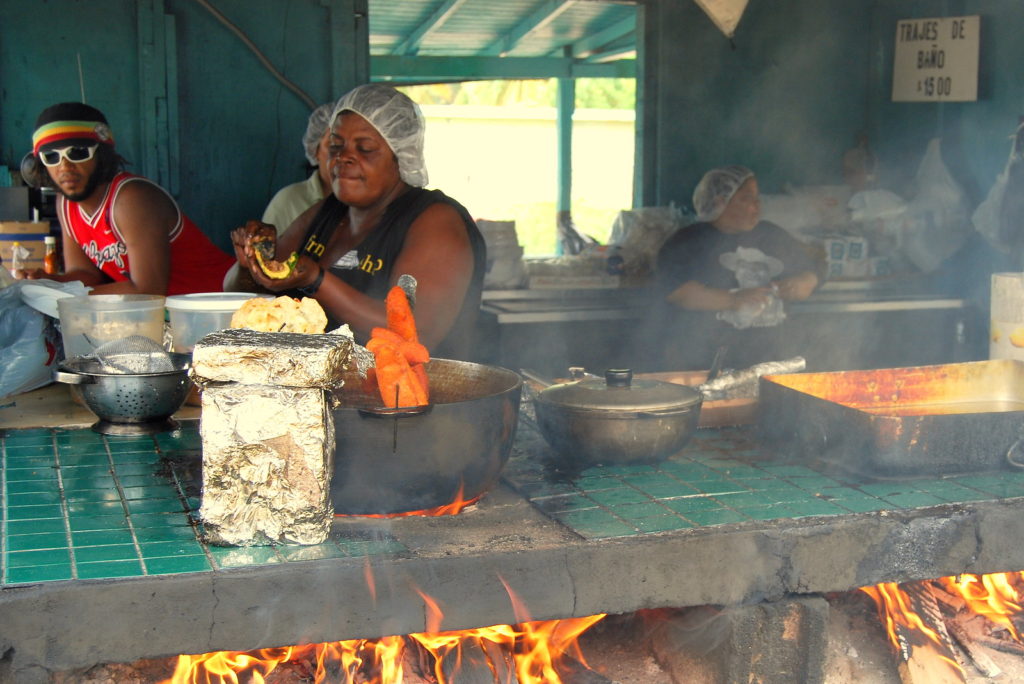
Visiting Piñones is a local tradition, especially on weekend afternoons. These ramshackle food stands have been operating for years. No matter which you pick, the atmosphere is rustic, to be kind. The service is slow, to be kind. The food is really greasy, to be kind. But the piña coladas are perfection. Carrying your oily lunch to the beach to picnic in the sand while watching the waves crash is an unforgettable experience, not to be missed.
You know what IS forgettable, though? The food. For example, alcapurrias (al-kuh-por-EE-yuhs) are grease-laden lumps of dough with a dash of some sort of meat or seafood. They soak into your tongue before you can swallow, then sit in your stomach and take up residence like guests who refuse to leave.

Am I sorry I had this experience? Absolutely not. It’s true Puerto Rico. (And now I know to avoid alcapurrias.)
Would I recommend it? Absolutely. (But maybe just once.)
A word to the wise, though: Don’t eat Chinese food in Puerto Rico. We have had excellent Chinese food in many places, including Guadalajara, Mexico. But on the Island of Enchantment? Not once. Just don’t go there. It is universally terrible. The meat has a weird texture. The sauces are limited, and taste odd. The vegetables are sparse, and none of them are Chinese. Every dish, inexplicably, comes with a side of soggy French fries. (Gotta get that deep-fried in!) Please. Anything but this.
The latest trend in Puerto Rico is our favorite–food truck parks.
These are brilliant for a number of reasons:
We are living in western Puerto Rico at the same time (January through March) that humpback whales are migrating, mating and birthing in the ocean at this end of the island, in the channel between us and the Dominican Republic. So we decided to book a whale watching trip. We chose Taino Divers out of Rincon, who operate a two-hour sunset cruise from Black Eagle Beach. They don’t promise you’ll see whales–they are wild animals, after all–but we saw plenty, while also enjoying a choice of cold beverages, from water and soda to rum punch!
We could have swam in the 1,000-foot-deep ocean if we had thought to wear our suits. Next time! Maybe we’ll even be able to hear whales singing underwater.
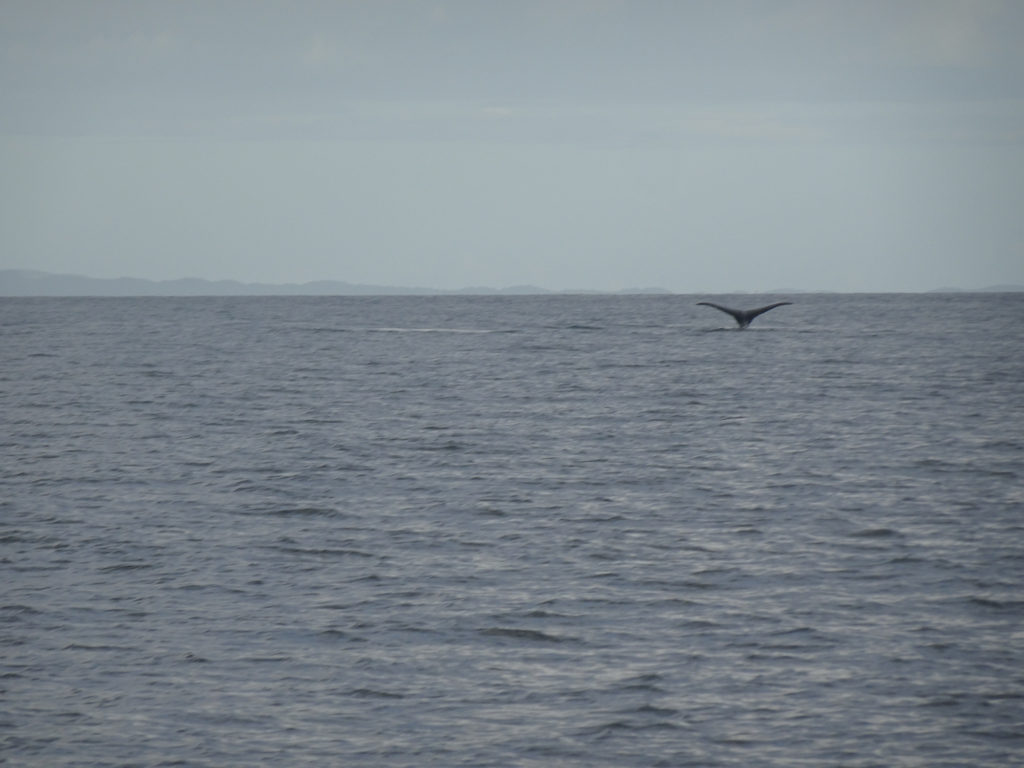
Humpback whales are mammals the size of a school bus who live in the ocean. They’re called humpbacks because of the shape they take when they dive deep into the water after popping up to the surface.
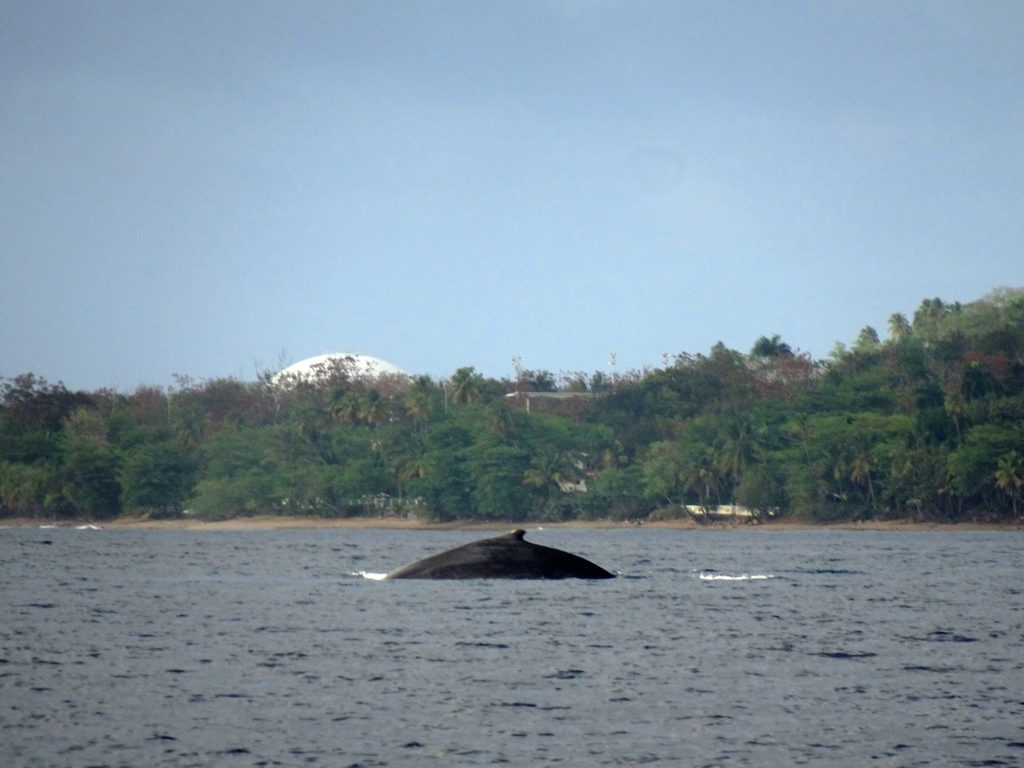
These whales hunt and feed up north in the summer, then head south to warmer waters and fast during the winter, living off their blubber while they focus on migration and mating. They travel in packs called pods, so we saw several groups swimming together.
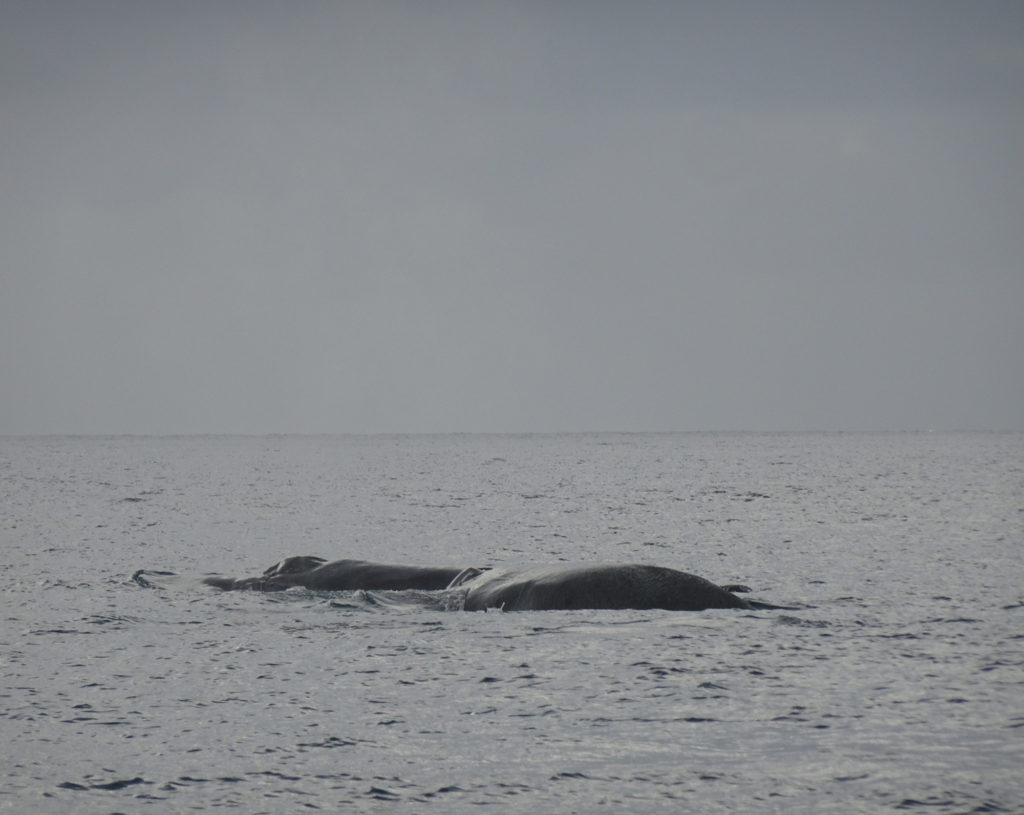
Our guide said when we see the flippers, that means the whale is diving deep, so it’s time to look for them to emerge elsewhere.
Not sure what the point of the blowhole is. We saw those spraying into the air.
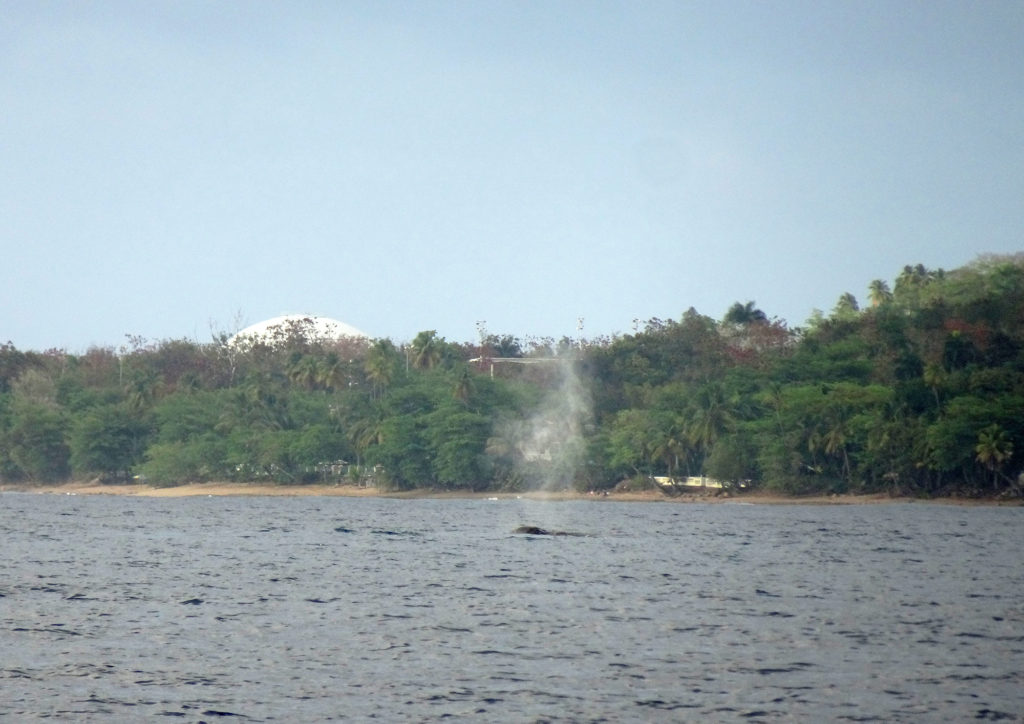
The cost was $64 pp plus tax and tip. Definitely worth it for an awesome experience! We’ll definitely be going back with our son Gavin when he visits next week.
We’ll have a whole video on the humpbacks coming out on our YouTube channel soon. You might want to take some Dramamine before watching it, because the boat was rocking in the water.
Here are a few acts about humpbacks from livescience.com:
Humpback whales are not the biggest whales—that’s the blue whale. Still, humpbacks can grow to 60 feet (18 meters) long, and they can weigh a whopping 40 tons (about half the size of a blue whale), according to the National Oceanic and Atmospheric Administration (NOAA). Their flippers can grow up to 16 feet long, which is the largest appendage in the world. Their tails are also massive and grow up to 18 feet (5.5 m) wide. Like most whales, females are larger than males.
Visit the website to learn more!
Snorkeling is one of the most inspiring activities you can do. It’s a privilege to be able to float in the water alongside sea life, looking down on spectacular coral and finding yourself magically surrounded by colorful fish.
But with that freedom comes great responsibility, as Peter Parker’s gentle Uncle Ben would say. Coral is very fragile. It’s battered daily by currents, and sometimes severely damaged by hurricanes. But its greatest enemy is humanity. Whether it’s monstrous oil spills, boat engines, or the fins on your feet, coral is easily damaged and takes years to grow back. So don’t be part of the problem, and don’t damage the coral!

Wear reef-safe sunscreen: Use reef-safe sunscreen so that you don’t put chemicals in the water that can hurt the coral. Learn more.
Maintain safe distance: Do not swim too close or touch the underwater flora and fauna.
Watch your feet: Don’t step on or kick the coral because it can destroy their growth.
Follow directions: Always follow your snorkeling guide’s instructions whenever you are in the water.
Avoid contact with marine life: Never feed, touch or remove seawater animals or plants
Swim well: By swimming well, you will be able to control your movement underwater and not step on the coral reef. If you’re not a strong swimmer or haven’t snorkeled before, wear a life vest.
Other tips: Always make sure that your snorkeling gear is adequate and comfortable.
Support Reefs: Support the conservation project in the area you are snorkeling. We joined the Rincon chapter of Surfrider.com.
Info for this posting came from Snorkeling tips without damaging coral reef, an article in the Jakarta Post.
Photo from https://snorkelaroundtheworld.com/2018/07/safe-snorkeling-10-tips-for-your/
In support of Ukraine, we have canceled the Russian (Blue), Ellie, from our logo.
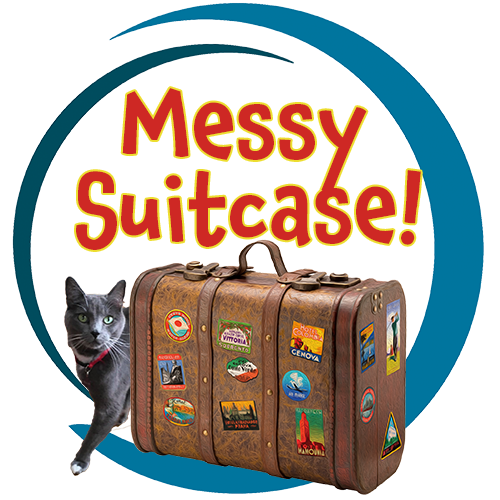
Just kidding. We may not be drinking Russian vodka, but we could never cancel Ellie!
But Ellie is living at college with Gavin now, and isn’t traveling with us anymore. Kaylee is. And it was time for her to ascend to her rightful place on the throne … er, messy suitcase.
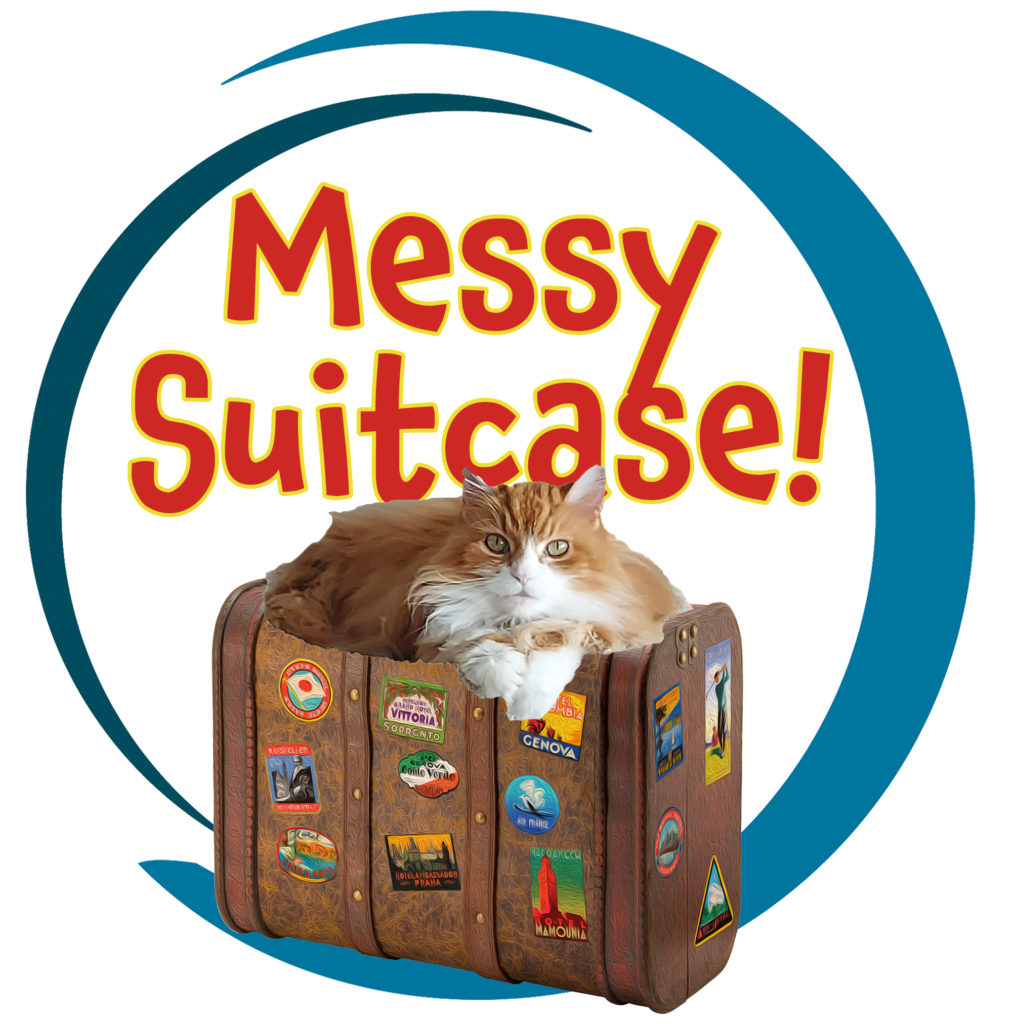
All hail Kaylee!
Traveling in retirement is not all sweetness and light, despite what Messy Suitcase’s social media might suggest. We post photos from beautiful beaches and interesting places, but usually don’t share the logistics of how we got there. Or how we ran from the beach to the car because of a sudden unexpected downpour. Or about the fact that I am currently nursing a broken rib from tripping on a root and falling during a hike. There are plenty of obstacles and inconveniences to our traveling retirement that we grapple with daily, just like there were when we still worked.
We decided it was time to share a few, to give our lifestyle some balance, in this new series, Trouble in Paradise. In Part 1, we focus on transportation.
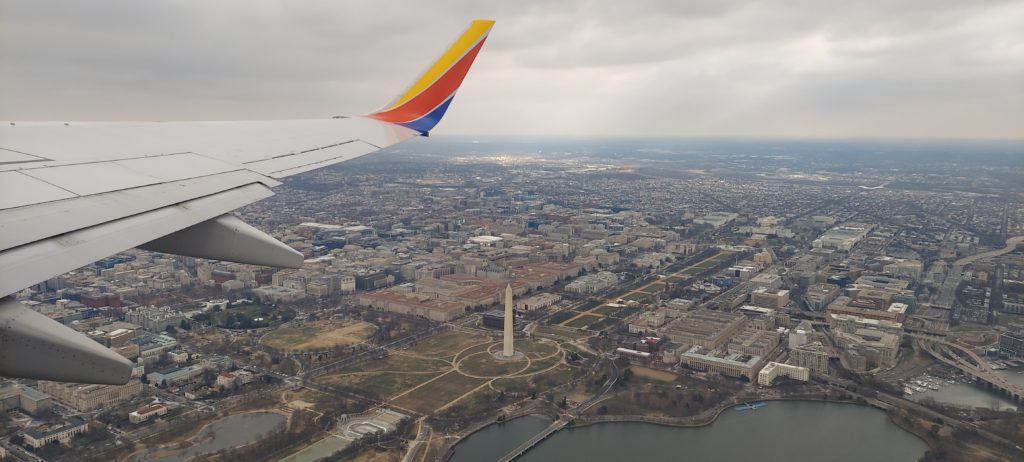
Air transportation is an unavoidable hassle if you’re going to live a traveling life. As soon as we arrive in a place, we have to start planning how and when we are going to get to the next one. We fly almost exclusively on Southwest Airlines right now, because we have thousands of airline miles and a Companion Pass good through the end of 2022. This helps keep our retirement life affordable. But it’s not always convenient, especially in the time of COVID.
For example, in January we booked a flight back to the United States from Puerto Rico for May 3, 2022. Last week, Southwest changed it so egregiously that the second leg was the day before the first, a physical impossibility. It took hours to fix this, including long telephone wait times, until they finally fixed the glitchy website so we could change the flight online. Then, two days later, they changed the flight again! We were originally going to arrive in DC at 8 PM. At this point, it’s 10:15 PM. I can’t wait to see what happens next (she said sarcastically).
Traveling during COVID times means securing the right kind of COVID-19 tests (as specified by the airline or the government of the place you’re entering), getting them administered correctly, with results returned in the specified time frame, filling out all airline COVID forms, making sure we have the safest masks to protect us, and choosing seats near the back of the plane (the safest part).
Fitting everything you need for three or four months of life into your luggage is difficult as well, especially if your lifestyle includes snorkeling and other athletic pursuits. Alas, my bike doesn’t fit in my suitcase, but I pack bike shorts and a helmet for when I am able to rent a bike. My tennis shoes fit, and just one tennis outfit, but I have to rent a racket at the club where I play. And speaking of shoes, while I am no Carrie Bradshaw, I cannot travel for months on end without all of my favorite Aetrex sandals! As well as running shoes. And hiking shoes. And Keens for the beach. It adds up.
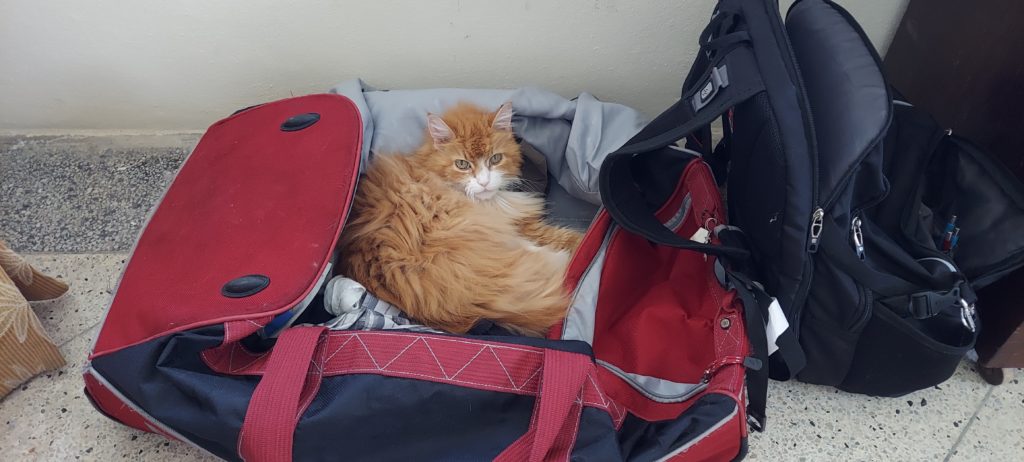
And then there’s the TRX home workout equipment, and a yoga mat, for staying strong and flexible, even while on the road. There’s snorkel gear. There’s the cat’s stuff, toys and litter box, bowls, and food. There’s jewelry. And my computer and tablet. And chargers. Sweaters and pants for cool evenings. bathing suits and goggles. Vitamins and medication. Toiletries. A hair drier.
I think you get the picture. We pack as light as possible, but it’s still a lot of stuff.
When we were living in Mexico, we drove our covered Toyota Tacoma down from the United States, after retrofitting the back latches of the cap to secure our possessions. We would then park where we were living, and rely as much as possible on public transit or Uber.
Public transit can really simplify life, but first, it complicates it, because you have to learn how it works in every city. How much does a ride cost? Bus or subway? Do you get a ticket? Pay cash? Exact change? A Metrocard? An app on your phone? Where are the stops or stations? What are the hours? What about transfers? Safety? How do you get from Point A to Point B? There’s a trip planning app called Moovit that really helps with this. Google Maps also helps chart a public transit route.
Uber is another great resource – better than cabs, in our opinion, because it’s more secure, and you know before the car arrives what it will cost to take you to your destination, and many drivers are happy to share their recommendations for restaurants, neighborhoods to visit and local experiences.
But we often need to rent a car. It’s a huge expense, and finding one that doesn’t break the bank when you are staying for months at a time is really hard. Last year, we found a deal on Enterprise after searching for weeks. Then, when we arrived in Puerto Rico, they told us we would have to bring the car back to San Juan International Airport every month to renew it. Since we were traveling to the east end of the island, that was a huge inconvenience. So on the renewal day, we spent an afternoon searching for an Enterprise local to our lodging, had that worker call San Juan, and got the car extended – we hoped.
A couple of weeks later, we found a $150 ticket on the car for expired registration. They had given us a car for three months without making sure the registration would last the duration! Bob got pulled over again the following week for the same issue, but was able to talk his way out of a ticket. We spent the last few weeks dodging police traffic stops so that we wouldn’t get another ticket. We got Enterprise to cover the cost of the ticket, in the end, though I thought they might blame us because we had not brought the car to San Juan in person after a month as instructed.
We took that first car, a Ford Focus I believe, on a rutted dirt road to a deserted beach and managed to loosen the front left quarter panel, then spent the next two months pushing it back in place daily. The car was a very low rider, and every bump in the road scraped that damned quarter panel. (We noticed that most cars had the same problem; roads in Puerto Rico can be very bad.) In the end, there was an insurance claim on the car, which was covered by a combination of our USAA Auto Insurance and the coverage provided by American Express. Still, a hassle!
We are currently renting from Avis at a low(ish) rate I secured through Priceline. The first car they gave us had a nonworking cigarette lighter, which we needed to power our GPS. (We had discovered there are dead spots in the mountains and will no longer travel without the GPS. See Packing for why this is an inconvenient solution.) We took the car back immediately and got upgraded to the only other car on the lot, a Hyundai Tucson SUV, which is actually way better for Puerto Rican driving.
But … five weeks into our stay this time, Bob looked at the front wheel and saw this:
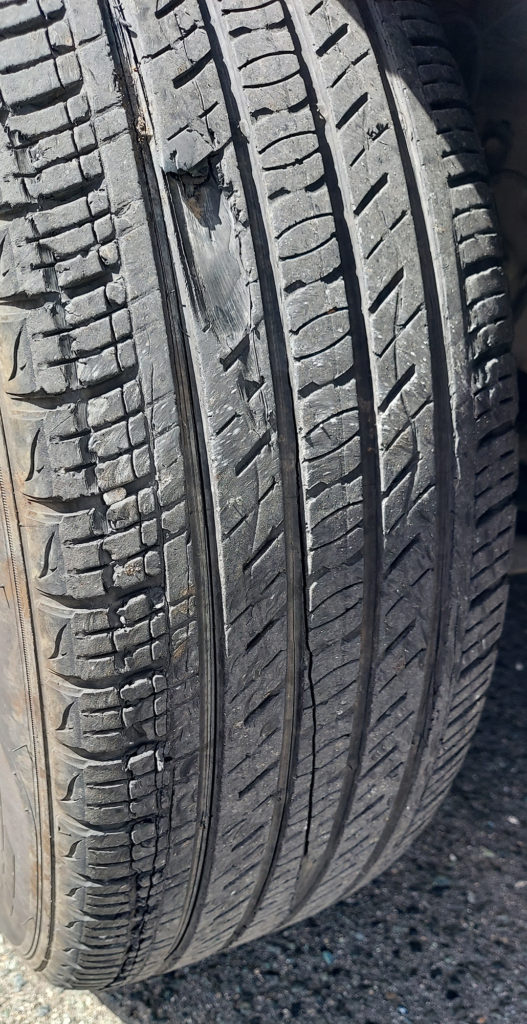
Holy shit! We were driving on a grossly defective tire that looked like it could explode catastrophically at any time! We called Avis Roadside Assistance in Puerto Rico. Busy signal. FOR TWO DAYS. We called the local Avis, at Aguadilla Airport, 20 minutes away. Non-stop ringing, or busy signal. FOR TWO DAYS. We called Avis in the United States. They connected us to US Roadside Assistance, who told us to call PR Roadside Assistance. I sent an email to Avis. They apologized for any inconvenience – four days later – told us to call PR Roadside Assistance. I lost all my hair pulling it out in frustration.
In the end, we just drove to the damned airport, where of course, the solitary Avis employee was not coming in for another hour. We went out to lunch, returned, and a miracle happened. The man at the desk made a phone call, gave us instructions to a gomera (tire place), and the tire was changed before we had time to finish piña coladas at a bar down the road.
We found a ticket on our car again last week when we returned to it after a day at the beach. I knew the registration wasn’t expired – it was the first thing I had checked. Puerto Rican traffic tickets are almost impossible to decipher, but I finally figured out that we had parked facing the wrong direction, and had to pay $50. It would be knocked down to $35 if we paid within 2 weeks.
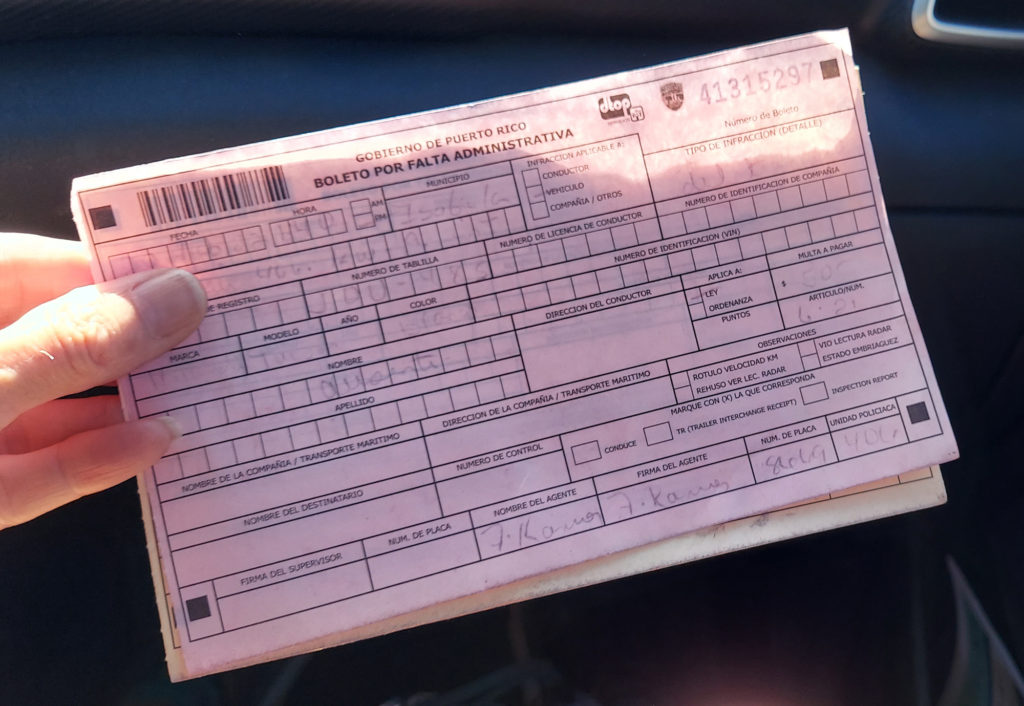
But how to pay? There was no website, no address to mail. Off to Mr. Google! I found guidance here – and learned that you have to pay in person – isn’t this 2022, people? – at a place called CESCO (the Motor Vehicles Department). There’s a CESCO Office near the Avis place in Aguadilla, so we went there after getting our new tire. The CESCO person sent us to another office, Hacienda (Finance department), at the other end of the same strip mall, where we joined a socially-distanced outdoor line of people holding boletos (tickets).
While Bob waited, I bought breakfast pastries at the bakery next store, and on the way back noticed a barcode on the Hacienda door that would have allowed us to schedule our appointment in advance and not wait in line. It would have been nice to know about that! But we were there already, in line, and hoped we were close enough to the front to get in before the office closed for the day at 3:30 PM (although the website said it closed at 5.) We were fortunate to be the last people allowed in! And both the door monitor and the woman behind the desk (one of only two people working inside) were extremely helpful friendly and spoke English. The woman did warn us to make sure we provided the car rental agency with evidence this ticket was paid so they wouldn’t try to charge us for it again.
Since we flew to PR from Washington National Airport, our Toyota Tacoma is parked in an underground garage in Crystal City, VA, for what I considered a very reasonable monthly rate of $130. I did a lot of research to find this low rate at this convenient location. Imagine my surprise when I received an email from SpotHero last month, two weeks after I parked the car there, telling me the rate was going up to $200 – a 50% increase – beginning the very next month! Obviously, there is no way to move this car out of the garage until we return. We just have to suck it up. And though I wrote a scathing email to SpotHero, I received no response and have no recourse but to pay until we take the car out on May 4.
Up next …